|
 |
| |
AUTOMOBILE FRAME AND BODY
FRAME
 |
The frame is the most important part of any vehicle. It provides a firm structure for the body and a solid anchor point for the suspension system. Frames are made to be rigid and this keeps all the other parts of the car in alignment.
|
|
BODY
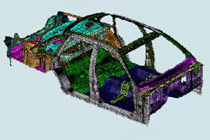 |
The body shell of your car is made of large steel sections which protect the occupants from collisions and elements outside the car. It also provides solid mounts for all other systems and is able to cut through the air with minimal resistance. |
|
ENGINE
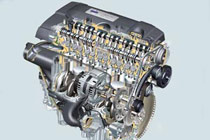 |
The engine produces the drive power that propels a vehicle forward or backwards.
There are many engine configurations available in today's market. The most common are 4-cylinder, 6-cylinder, and 8-cylinder engines.
|
|
STEERING SYSTEM
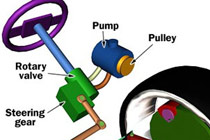 |
A vehicle's steering system is made up of a steering wheel, gears, linkages, and other components.
Together these parts control the direction of the vehicle's movement.
|
|
SUSPENSION SYSTEM
 |
In automobiles, the frame, body, engine, and power train are suspended above the wheels by a system of springs. This spring system (called the suspension) lessens the jarring caused by road irregularities. The suspension must also keep the wheels in close contact with the road surface at all times. |
|
ELECTRICAL SYSTEM
Battery:
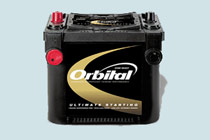 |
The battery is your vehicle's primary source of electrical power. When the ignition switch is turned, the power from the battery turns the starter motor. This fires the engine and brings your vehicle to life. |
|
Alternator:
 |
The alternator generates power for the vehicle systems and charges the battery while your vehicle's engine is running. |
|
ELECTRICAL SYSTEM
Electricity is distributed throughout your vehicle by various electrical circuits. It is used for lighting and operation of electrical motors and computers. It also powers your radio and your car's interior cooling, heating, and ventilating system.
The automobile lighting system includes a wiring harness, lights, and control switches. |
FUEL SYSTEM
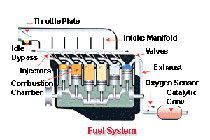 |
Your vehicle's fuel system delivers fuel and air to the engine.
Gas is stored in a fuel tank, usually located near the rear wheels of the vehicle. The fuel pump sends gas from the fuel tank through the fuel line and fuel filter to the carburetor or fuel injector. The air is brought through the air filter and the intake manifold.
|
|
Fuel Pump:
 |
The fuel pump has three functions.
Most importantly, it delivers fuel to the engine. It also keeps the fuel from boiling by maintaining the pressure in the fuel line and it prevents vapor lock.
|
|
Fuel Filter:
 |
Clean fuel is important. There are many small jets and passages in a carburetor and openings in a fuel injector that need to stay clean so your engine can function properly. To ensure this cleanliness, fuel filters are installed in the fuel line. |
|
Carburetor:
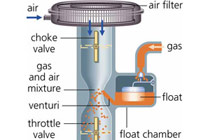 |
The carburetor meters the mixture of fuel vapor and air in an internal-combustion engine and sends this mixture to your engine's cylinders. |
|
Fuel Injector:
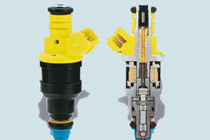 |
Most modern cars have fuel injectors instead of carburetors.
The fuel injector is supplied with pressurized fuel by the fuel pump. When the injector is energized, an electromagnet moves a plunger that opens the valve, allowing the pressurized fuel to squirt out through a tiny nozzle. |
|
Intake Manifold

|
An intake manifold is a system of passages which move the fuel mixture from the carburetor to the intake valves of the engine. Manifold design helps the engine operate efficiently. |
|
COOLING SYSTEM
 |
Heat is caused by the friction of moving engine parts and the explosion of gasoline in the cylinders. This heat is then removed through the vehicle's cooling system. |
|
How the cooling system works:
 |
The heat is absorbed by a coolant (a mixture of water and chemicals) flowing through passages inside the engine. This coolant protects the cooling system from corrosion, lubricates the water pump, and prevents freezing. A water pump circulates the coolant through the hoses within the cooling system while the engine is running. |
|
Radiator:
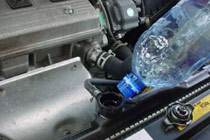 |
The radiator, which stores the coolant, is responsible for reducing heat in the coolant. The radiator is cooled by air that flows through when the vehicle is in motion and by the radiator fan(s). Most radiators have a recovery tank that captures coolant as it expands (because of heat) and returns it to the radiator when cooled. |
|
 |
The flow of coolant is controlled by a heat-sensing valve called a thermostat which allows your engine to quickly heat up to proper running temperature. |
|
BRAKE SYSTEM
 |
Your vehicle comes with two independent braking systems: the regular brakes and the parking brake (also known as the emergency brake).
Regular brakes slow your vehicle while you are driving. The parking brake can also be used to slow your vehicle in an emergency, but it is mainly used to hold your vehicle in one place while stopped or parked. |
|
DISC BRAKES
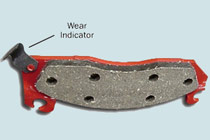 |
There are two types of regular brakes used to slow your car while driving: disc brakes and drum brakes. Both types use friction to slow the wheels.
On disc brakes, when you hit the brakes a piston causes the brake shoes (pads) to grip a spinning disc and slow the wheel via friction.
|
|
DRUM BRAKES
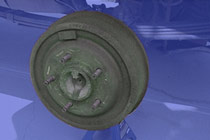 |
Like the disc brake, the drum brake has two brake shoes and a piston. When you hit the brake pedal, the piston pushes the brake shoes against the drum. |
|
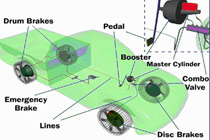 |
Many cars have drum brakes on the rear wheels and disc brakes on the front. You must refer to your owner's manual if you are not sure what type(s) of brakes are on your vehicle. |
|
Brake Fluid:
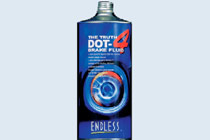 |
Brake fluid is a special liquid used in the brake hydraulic system.
Brake fluid transmits force to various parts of the braking system when you step on the brake pedal. |
|
The U.S. Department of Transportation issues specifications for brake fluid. The three main types of brake fluid now available are: DOT3, DOT4, and DOT5.
DOT3 and DOT4 are glycol-based fluids that absorb water. DOT5 is silicon-based and does not absorb water.
There are also two important things about brake fluid: DOT3 and DOT4 remove paint. So don't spill it on your car! Also, different types of brake fluid should not be mixed. Different brake fluids can react badly with each other and corrode your brake system. |
Brakes lock when the vehicle is stopped and the brakes are engaged. The friction force between the tires and the road keeps the vehicle from moving. Your parking brake uses a cable rather than a hydraulic system to engage the brakes. It clamps down on the drive shaft. Therefore, your parking brake will function even when the regular brakes have failed.
|
ABS (ANTILOCK BRAKING SYSTEM)
|
An Antilock Braking System simply keeps your base brakes?whether drum or disc?from locking up. In vehicles not equipped with ABS, the driver can manually pump the brakes to prevent wheel lockup. In vehicles equipped with ABS, the driver's foot remains firmly on the brake pedal, allowing the system to automatically pump the brakes. |
|
|
The theory behind antilock brakes is simple.
A skidding wheel has less traction than a non-skidding wheel. If your brakes lock up on wet and slippery roads or during a panic stop, you lose steering control and your vehicle can spin. By keeping the wheels from skidding while you slow down, antilock brakes benefit you in two ways: You'll stop faster, and you'll be able to steer while you stop.
|
|
|
Rear wheel ABS prevents wheel lockup so that your car stays in a straight line. If your car has ABS control on all four wheels, you also keep steering control. If you have steering control, it is possible to avoid a collision by steering around hazards if a complete stop cannot be accomplished in time. |
|
|
The ABS engages when a wheel speed sensor detects impending wheel lock-up and prevents skidding during emergency braking. When the ABS engages, your car will feel a slight "shuddering"?resist the impulse to take your foot off of the brake when this happens. The ABS is working, and your job is to steer. |
|
|
 |
| |
|
|
|
|
 |
 |